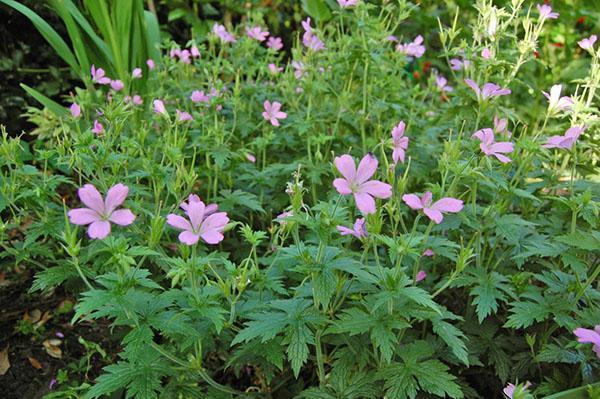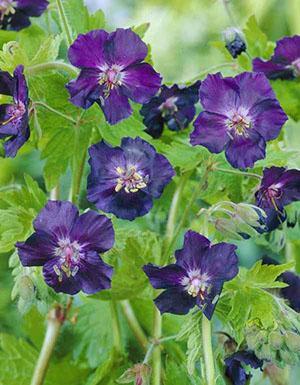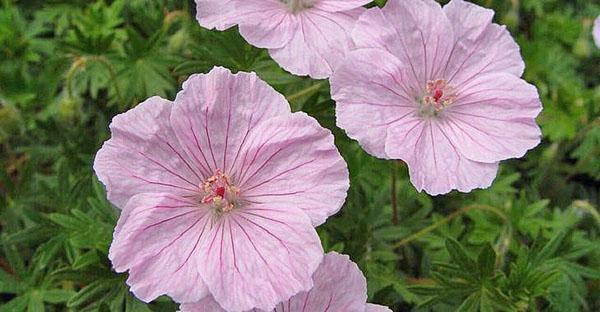A perennial garden geranium came from the forest to the flowerbed
 Wild varieties of geraniums can be seen in almost all regions with temperate, subtropical and even tropical climates. The perennial garden geranium was introduced into the culture by the ancient Greeks, and for the similarity of the fruit with long bird beaks, it was nicknamed geranion, that is, the crane.
Wild varieties of geraniums can be seen in almost all regions with temperate, subtropical and even tropical climates. The perennial garden geranium was introduced into the culture by the ancient Greeks, and for the similarity of the fruit with long bird beaks, it was nicknamed geranion, that is, the crane.
Geraniums in the garden: guests from the wild

In the wild, geraniums prefer to settle in meadows, under the shade of coniferous and deciduous forests, in the mountains and along rivers. Cultural varieties of perennial geraniums:
- preserved the unpretentiousness of natural plants, their adaptability to severe winters, dry summers;
- became more decorative and vibrant, some of them bloom twice a season, they are distinguished by variegated foliage and especially large flowers.
In addition to simple flowers inherent in the vast majority of geraniums, garden, perennial varieties and hybrids can delight the grower with terry flowering, as well as shades that cannot be found in a meadow or in a forest glade overgrown with geraniums.
Geraniums in the garden differ in the size and shape of the bush, the range of colors, color and type of foliage. Most plants have flat or cupped corollas with five distinctly veined petals. Geranium leaves are no less beautiful than its flowers. Depending on the type, they can be even green or variegated in color, be rounded or fancifully dissected.
Reproduction of perennial street geranium
When comfortable growing conditions are created, the ripe fruits of the plant spontaneously open and the seeds scatter far around the neighborhood. And in spring, seedlings are found far from the main plantings of geraniums.
On the one hand, self-seeding allows you to update and unobtrusively change the appearance of the garden. On the other hand, with regular planting, geraniums sprouting independently in the garden are not a pleasant surprise. In order to avoid self-seeding, it is better to remove unripe fruits.
 If a grower is going to use his own seeds for sowing, he has a difficult task to solve. Drying ripe fruits instantly open up, and unripe seeds may not give the desired shoots. Therefore, in advance, the tops of the peduncles with fruits are hidden in small canvas bags and tied from below so that the seeds remain inside.
If a grower is going to use his own seeds for sowing, he has a difficult task to solve. Drying ripe fruits instantly open up, and unripe seeds may not give the desired shoots. Therefore, in advance, the tops of the peduncles with fruits are hidden in small canvas bags and tied from below so that the seeds remain inside.
Due to the hassle of the process and the non-guaranteed receipt of seedlings, seeds for propagation of garden perennial geraniums are rarely used. It is much more efficient and easier to get a new plant by dividing an adult bush.
Storage and care of geraniums before planting in the country in spring
 If a geranium already available in the garden or on the street is planted, you can divide the bush and plant its parts in early autumn.When a rhizome with buds has to be bought and there is no way to plant geraniums in the ground before the onset of cold weather, it is important to keep the rhizome dense and viable.
If a geranium already available in the garden or on the street is planted, you can divide the bush and plant its parts in early autumn.When a rhizome with buds has to be bought and there is no way to plant geraniums in the ground before the onset of cold weather, it is important to keep the rhizome dense and viable.
It is important to remember that perennial street geraniums have well-developed peripheral roots. In the planting material, this part of the root system should be preserved until planting, and later provide the plant with nutrition and moisture.
For this, the rhizome is poured peat and placed in a container or perforated bag. In this form, the future garden geranium should be at 1-4 ° C until planting. The peat substrate must be slightly moistened, making sure that the roots do not dry out or rot. The container is chosen so that the roots are completely covered with soil and not intertwined.
 If the plant, even in a basement or refrigerator, has started to grow, it should be transferred to a bright, cool room. Here perennial garden geraniums will be planted in deep containers and light nutritious soil and the usual care, which includes moisturizing the substrate.
If the plant, even in a basement or refrigerator, has started to grow, it should be transferred to a bright, cool room. Here perennial garden geraniums will be planted in deep containers and light nutritious soil and the usual care, which includes moisturizing the substrate.
The easiest and most reliable option for planting and caring for perennial garden geraniums is to purchase planting material with a closed root system. Such seedlings easily take root and can be transferred into the ground at almost any warm season.
When can you plant geraniums outside? Plants do not suffer much from frost, and most species quickly begin to grow in a new location. Therefore, when the soil warms up to 15–18 ° C, the rhizomes can be transplanted into open ground. Depending on the region and weather conditions, this time most often occurs in the first half of May. If there is a threat of frost at night, it is better to cover unrooted geraniums in the garden with non-woven material.
Planting geraniums in the garden and caring for the crop
 The existing today ornamental varieties of garden geranium flower growers owe the interest in this plant of breeders from Holland and Great Britain. Despite the fact that these cultivated species have become brighter, their flowering is more abundant and longer, geraniums in the garden require the selection of conditions close to those in which their wild ancestors grew.
The existing today ornamental varieties of garden geranium flower growers owe the interest in this plant of breeders from Holland and Great Britain. Despite the fact that these cultivated species have become brighter, their flowering is more abundant and longer, geraniums in the garden require the selection of conditions close to those in which their wild ancestors grew.
When geraniums are planted in open ground in spring, the planting site is chosen depending on the variety and type:
- Meadow, Himalayan or gorgeous outdoor geraniums will actively grow and bloom if the plants are in the sun and are provided with abundant watering.
- In the dry corners of the garden, where there is a lot of sun, the large-flowered and red-brown varieties are irreplaceable.
- On alpine slide Georgian geranium looks good.
- If at the summer cottage there is a damp corner in the shade of trees, swamp geraniums will grow beautifully here.
- When planting and caring for a summer cottage, Balkan geranium easily tolerates drought and shading.
 All geraniums have branched long roots, which are extremely difficult to transplant. To reduce the stress from this procedure and to simplify subsequent care, a rather deep planting hole is made for planting geraniums in the garden. Its depth should be several centimeters deeper than the length of the roots spread over the nutrient soil at the bottom of the pit. After careful filling, the planting site is watered, and the soil is mulched from above.
All geraniums have branched long roots, which are extremely difficult to transplant. To reduce the stress from this procedure and to simplify subsequent care, a rather deep planting hole is made for planting geraniums in the garden. Its depth should be several centimeters deeper than the length of the roots spread over the nutrient soil at the bottom of the pit. After careful filling, the planting site is watered, and the soil is mulched from above.
Since most species grow significantly in a couple of years, there should be at least 20-30 cm between individual geraniums in the garden.
Due to the density of the crown and the emitted essential oils, weeds are reluctant to settle next to geraniums, and also not all pests can harm ornamental crops.
And yet even such an unpretentious plant capable of standing up for itself needs support. Caring for geraniums in the garden after planting consists of:
- in regular watering, meeting the needs of a particular type of plant;
- in dressings, the first of which is carried out with the help of infusion of compost and peat immediately after transplanting;
- in the autumn pruning of withered foliage and the summer removal of wilted inflorescences.
 Spring for geraniums should begin with nitrogen fertilization. It will push the plant to the formation of lush foliage, and after a month a complex agent is introduced under the plants, which contains nitrogen, phosphorus, potassium and trace elements. Species that are accustomed to living in the mountains or arid regions require less fertilization than the plain varieties.
Spring for geraniums should begin with nitrogen fertilization. It will push the plant to the formation of lush foliage, and after a month a complex agent is introduced under the plants, which contains nitrogen, phosphorus, potassium and trace elements. Species that are accustomed to living in the mountains or arid regions require less fertilization than the plain varieties.
Perennial garden geranium is an unusual, undemanding and very attractive green decoration of any site. The plant is versatile and can be successfully used in single and group plantings, without the need for special care.